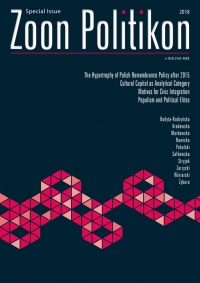The Hypertrophy of Polish Remembrance Policy after 2015: Trends and Outcomes
The Hypertrophy of Polish Remembrance Policy after 2015: Trends and Outcomes
Author(s): Tomasz StryjekSubject(s): Politics, Political history
Published by: Collegium Civitas
Keywords: remembrance policy; politics of memory; identity policy; historiography; Institute of National Remembrance; museums; public holidays and memorial days; Central and Eastern Europe
Summary/Abstract: Polish authorities have placed so much importance on remembrance policy since the end of 2015 that it has led to the hypertrophy of the phenomenon. From the 1990s, Poland has been at the forefront of shaping the infrastructure of this form of politics in Europe. Admittedly, even before 2015, national remembrance policy referred mainly to martyrologic and heroic experiences from the period 1939-1956, but it was the victory of Law and Justice in the elections in 2015 and the creation of a oneparty government that resulted in the repeated official declarations of the necessity to defend national “dignity”. This has been accompanied by wiping from national memory past crimes committed by Poles, particularly against Jews.
Journal: Zoon Politikon
- Issue Year: 9/2018
- Issue No: 1
- Page Range: 43-66
- Page Count: 24
- Language: English

